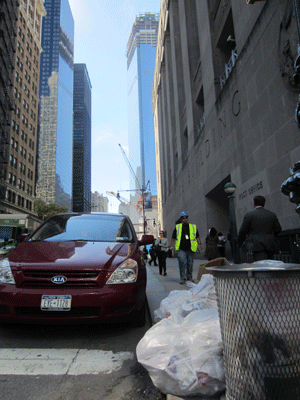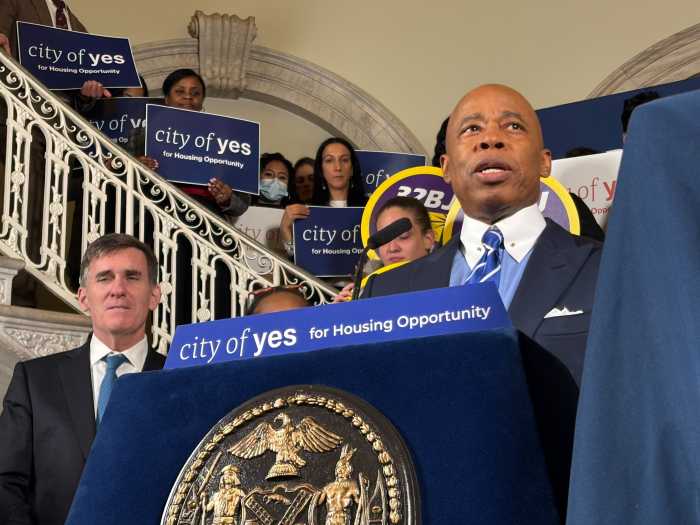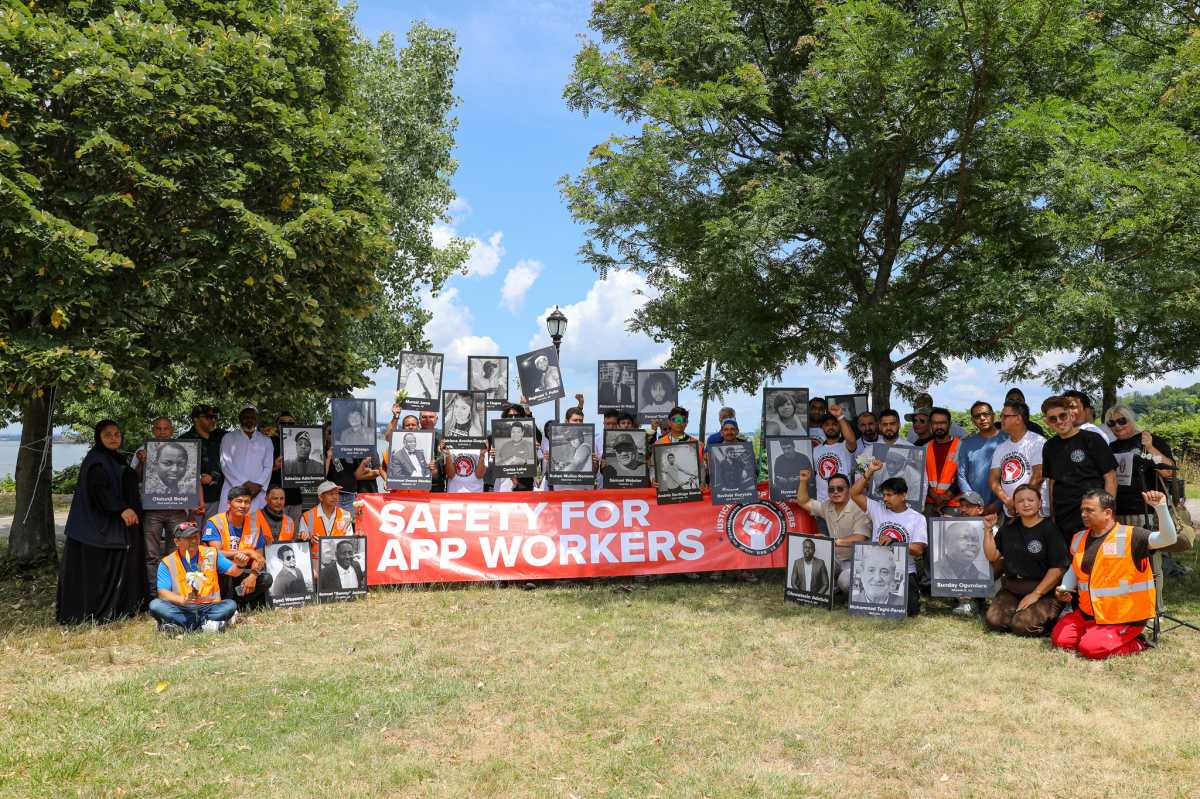
BY ALINE REYNOLDS | Lower Manhattan tourism has been booming ever since last year’s opening of the National Sept. 11 Memorial. The surging influx of out-of-towners, however, has come with its own set of problems that Downtown residents, elected officials and group leaders are hoping to solve.
That was the topic of discussion at a City Council hearing on Lower Manhattan tourism hosted by City Council Member Margaret Chin on Fri., Sept. 28, where a number of Downtown organizations and stakeholders testified. The consensus was that, while tourism is economically beneficial to the area, Downtown needs to be adequately prepared to maintain the quality of life for neighborhood residents and meet the heightened demand of goods and services.
An estimated 9.8 million tourists visited Lower Manhattan museums and other attractions last year — a 30 percent increase from two years prior, according to Chin, citing a news release put out by the Downtown Alliance Business Improvement District.
Visitors from upwards of 160 countries spent nearly $1 billion in Lower Manhattan over the past year, according to George Fertitta, chief executive officer of tour organization NYC & Company. The high tourism rate is in part due to publicity the group has done with its network of offices in 18 offices around the world. The BID has also played an active role in attracting more tourists to the area — from creating promotional videos for airplane and taxi passengers to launching tourist-friendly mobile applications. It is now in the process of developing a mobile kiosk program that will supply information to visitors in heavily traveled spots of Lower Manhattan.
While Lower Manhattan’s overall visitor count has more than doubled since 2005 — from 4.3 million to 10 million — the number of Downtown hotel rooms has mushroomed by 78 percent since before 9/11, according to Downtown Alliance president Elizabeth Berger. Six new Downtown hotels are being built, and nine others are in the planning stages, Chin said. Once completed, they’ll provide more than 2,700 new rooms.
Lower Manhattan’s cultural institutions are also thriving: the Museum of Jewish Heritage, for example, has experienced a 20 percent increase in visitors since 2010, while the Museum of American Finance saw a six percent increase in visitorship from 2010 to 2011. The National Museum of the American Indian, meanwhile, is counting on beating its most recent record of 350,000 visitors in the fiscal year that ended in September 2011.
The city, in turn, must do a better job of reinvesting the resulting revenue back into Downtown, Chin argued. “We have built a very successful tourist destination,” she said, “but there are underlying problems. I am calling on the city to confront these issues head-on and to provide this neighborhood with the support and resources it needs.”
For one, Lower Manhattan needs more directional signs and other way-finding devices, she said. Chin plans to introduce citywide legislation that would regulate how long garbage is left on the street — since, despite the presence of new bins at Liberty and Church Streets, trash continues to spill out of the wastebaskets and onto sidewalks.
Due to the lack of public restrooms, tourists have been using the facilities of local businesses. To address this problem, Chin allocated $500,000 of her budget earlier this year to construct a comfort station in Battery Park. Community Board 1, which testified at the City Council hearing, is proposing that the 9/11 Memorial Foundation install bathrooms for its visitors in the entrance area.
“The city has an obligation to build public bathrooms for the Downtown community,” said Chin. “It’s not fair that small businesses end up providing this service to visitors.”
The influx of tourists translates into an increased number of tour buses, thereby worsening area congestion, according to C.B. 1 chair Catherine McVay Hughes. Moreover, tourists stopping to take photographs and to observe local landmarks obstruct pedestrian and vehicular flow and contribute to street litter.
The board is particularly concerned about issues caused by the concentration of tourists on Liberty, Cedar, Greenwich and West Streets, and elsewhere in the vicinity of the 9/11 Memorial. “In this area,” said Hughes, “the streets and sidewalks are extremely congested as a result of construction-related scaffolding, street vendors, news boxes and news racks, and U.P.S. mail cartons.”
In anticipation of the opening of the 9/11 Memorial, New York Water Taxi was chosen as the official transportation provider for those visiting Lower Manhattan by boat, according to Travis Noyes, the company’s senior vice president of sales and marketing. Due to the program’s success, N.Y.W.T. has been able to expand Water Taxi service to Lower Manhattan — from seasonal to year-round — which more than 100,000 memorial visitors used to get from Midtown to the World Trade Center in the last year. The company offers all of its passengers free passes to the South Street Seaport Museum and discounts to dozens of area businesses.
Transporting Downtown tourists by water helps to relieve car congestion in the area, Noyes noted. “We estimate that our program alone reduced bus traffic to Lower Manhattan by over 2,000 individual trips,” he said. “We anticipate these numbers to grow further as the number of visitors to Lower Manhattan grows.”
In an effort to direct more of the 9/11 Memorial tourists to other Lower Manhattan neighborhoods, Chin is hoping to extend the Downtown Connection shuttle into Chinatown — though this added service would require sizeable capital funds.
Chin would also like to see safer roadways and more trains and bike lanes. In particular, she and C.B. 1 are advocating for the banning of bicyclists from City Hall Park, since they are seen as a danger to pedestrians. In other places, however, the community is encouraging bikers — at the Brooklyn Bridge, for example, and along the waterfront, where C.B. 1 is calling on the city to complete the bikeway that would link Hudson River Park with the East River.
Said Hughes, “Construction of the [waterfront] bikeway will convert acres of asphalt green to green space [and] help create order in an area overcrowded with pedestrians, vendors and tourists queuing for tour buses — and, increasingly, bikers.”
Additionally, Chin is considering a law that would modify developers’ current practice of automatically renewing scaffolding permits — as abandoned scaffolding is one of the top complaints from local residents.
“Currently, property owners can renew permits for scaffolding even when work is not being done on the property,” said the council member. “This creates an environment that encourages illegal dumping, homelessness and a dark and dirty atmosphere.”





























